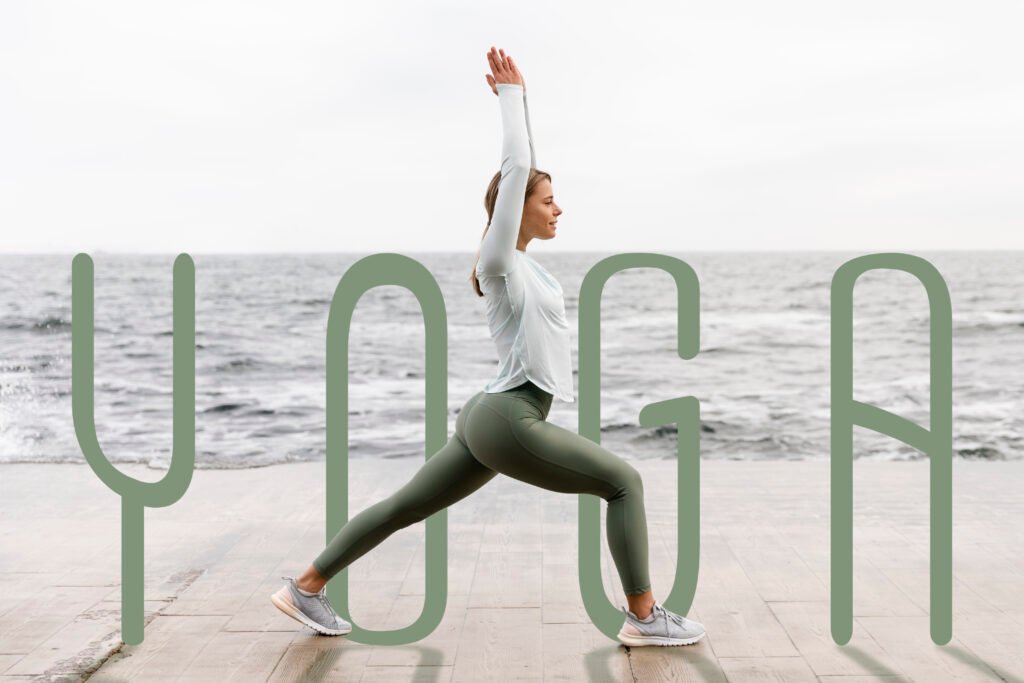Yoga For Novices: Types, Advantages And How To Practice
1. Hatha Yoga:
Hatha Yoga is one of the most by and large penetrated kinds of yoga in this current reality. A piece of yoga based on genuine positions (asanas), breath control (pranayama), and thought. “Hatha” itself is a blend of two Sanskrit words: “ha” importance sun and “tha” significance moon.
This blend tends to the amicability between going against the powers su n and moon, masculine and refined, warm and cold which experts hope to achieve through Hatha Yoga.
Here is a diagram of Hatha Yoga:
1. Physical Positions (Asanas): Hatha Yoga incorporates different genuine positions or asanas that are planned to expand, sustain, and change the body. These positions are much of the time held for some time and are performed with care and awareness of the breath.
2. Breath Control (Pranayama): Pranayama, or breath control, is a central piece of Hatha Yoga. Specialists sort out some way to coordinate their breath through various methodologies, for instance, significant breathing, substitute nostril breathing, and breath upkeep. Pranayama helps with calming the mind, increasing energy levels, and overhauling by and large flourishing.
3. Meditation and Relaxation: Hatha Yoga moreover merges reflection and loosening up procedures to quiet the mind and foster inside congruity. An examination could incorporate focusing in the cerebrum on a specific thing, mantra, or breath while loosening up techniques help with conveying strain and advance significantly loosening up of the body and mind.
4. Balancing Opposites: One of the basic principles of Hatha Yoga is the balance of going against powers like strength and versatility, effort and surrender, activity and quietness.
By practising asanas, pranayama, and consideration, experts attempt to mix these going against powers inside themselves, inciting more unmistakable physical, mental, and up close and personal balance.
Benefits of Hatha Yoga:
– Further creates Flexibility: Standard demonstration of Hatha Yoga can help with additional creating versatility and extent of development in the body, decreasing the bet of injury and overhauling overall compactness.
– Supports the Body: Various Hatha Yoga presents require strength and security, which helps with moulding and invigorating muscles generally through the body.
– Propels Loosening up and Stress Reduction: The highlight on cautious breathing and loosening up systems in Hatha Yoga can help with diminishing strain, advance loosening up, and work on everyday mental flourishing.
– Further develops Cerebrum Body Awareness: Through the demonstration of Hatha Yoga, experts encourage more noticeable knowledge of their bodies, breath, and mental states, developing a more significant relationship between mind and body.
– Maintains By and large Common demonstration of Hatha Yoga has been connected with different clinical benefits, including chipping away at cardiovascular prosperity, better rest, diminished strain and despairing, and redesigned safe ability.
Bit by bit guidelines to Practice Hatha Yoga:
1. Find a Confirmed Instructor: If you’re new to Hatha Yoga, consider going to classes driven by an ensured teacher who can guide you safely through the preparation and give tweaked directions considering your prerequisites and limits.
2. Start Slowly: Start with Fragile Hatha Yoga classes planned for juveniles, and continuously increase the power and length of your experience as you become all the better with the stances and techniques.
3. Listen to Your Body: Spotlight on how your body feels during each stance, and don’t push yourself past your endpoints. Honour your body’s necessities and limitations, and change behaves critically to suit your solitary level of flexibility and strength.
4. Focus on Breath Awareness: All through your preparation, stay aware of cognizance of your breath, and synchronize your advancements with your breath at whatever point what is going on permits.
Significant, cautious breathing can help with calming the mind, increase energy levels, and redesign the upsides of your preparation.
5. Practice Regularly: Consistency is basic to experiencing the full benefits of Hatha Yoga. Hope to practice reliably, whether or not it’s just for several minutes consistently. Find a standard that works independently and make yoga a piece of your regular presence.
Hatha Yoga, by and large, offers a thorough method for managing prosperity and thriving, consolidating real positions, breath control, and examination to propel balance, strength, flexibility, and internal concordance.
With commitment and practice, Hatha Yoga can be an earth-shattering outing toward more important care and centrality.
2. Vinyasa Yoga:
Vinyasa Yoga is a strong style of yoga that bright lights on arranging improvement with breath to stream reliably beginning with one stance and then onto the following.
It is regularly suggested as “stream” yoga because of the smooth changes between presents, synchronized with internal breaths and exhalations. Vinyasa Yoga is derived from the standard Hatha Yoga practice yet offers a more staggering and vivacious philosophy.
Key components of Vinyasa Yoga include:
1. Breath-Centered Movement: Vinyasa Yoga focuses on the relationship between breath and improvement. Each improvement is synchronized with either an internal breath or exhalation, making a predictable movement of breath all through the preparation. The breath fills in as a helper, helping specialists with moving cautiously and with assumption.
2. Fluid Transitions: In Vinyasa Yoga, presents are associated together in a gathering, making a fluid and dynamic improvement practice. Changes between presents are generally smooth and steady, allowing experts to stay aware of power and stream beginning with one position and then onto the following with no problem at all.
3. Creative Sequencing: Vinyasa Yoga classes now and again incorporate innovative and moved progressions of positions.
While there are standard progressions like Sun Good Tidings (Surya Namaskar), Vinyasa Yoga instructors have the open door to design game plans that suit the necessities and limits of their students. This combination keeps the work on interfacing with and testing.
4. Focus on Strength and Flexibility: Vinyasa Yoga creates courage, versatility, and diligence through a mix of dynamic turns of events and static holds. Presents range from fragile stretches to extra troublesome harmonies and inversions, offering open entryways for specialists to explore and expand their genuine limits.
5. Mindfulness and Presence: Like various sorts of yoga, Vinyasa Yoga upholds care and presence on the mat. By staying delicate to the breath and the sensations in the body, specialists foster a sensation of care and obsession that can help with quieting the cerebrum and advance a state of inward congruity.
Benefits of Vinyasa Yoga:
– Deals with Cardiovascular Health: The steady turn of events and dynamic nature of Vinyasa Yoga can raise the beat, further foster scattering, and redesign cardiovascular wellbeing.
– Fabricates Flexibility and Mobility: Vinyasa Yoga unites a large number of positions and improvements that help with additional creating flexibility, adaptability, and extent of development in the muscles and joints.
– Creates Guts and Endurance: The strength-assembling a piece of Vinyasa Yoga helps tone and support muscles generally throughout the body, including the middle, arms, legs, and back.
– Progresses Tension Reduction: The accentuation on breath care and cautious improvement in Vinyasa Yoga can help with diminishing strain, calm the mind, and advance loosening up.
– Overhauls Body Awareness: Through the demonstration of Vinyasa Yoga, specialists encourage more important body care, proprioception, and sensation information, which can additionally foster coordination and balance both on and off the mat.
Bit by bit guidelines to Practice Vinyasa Yoga:
1. Start with a Foundation: If you’re new to Vinyasa Yoga, contemplate going to youngsters’ very arranged classes or studios to get to truly know the fundamental principles and strategies of the preparation.
2. Focus on Breath: Give close thought to your breath all through the preparation, and let it guide your turns of events. Coordinate each improvement with either an internal breath or exhalation, and try to keep a predictable and melodic breath plan.
3. Listen to Your Body: Honor your body’s requirements and do whatever it takes not to impel yourself past your typical scope of commonality. Change behaves like expected to oblige your level of fortitude, flexibility, and adaptability.
4. Stay Present: Foster a sensation of care and presence during your preparation. As opposed to permitting your mind to wander, focus on the sensations in your body, the rhythm of your breath, and the ongoing second.
5. Practice Regularly: Consistency is basic to progress in Vinyasa Yoga. Expect to practice reliably, whether or not it’s just for a concise term consistently. As you foster strength, flexibility, and perseverance, you’ll find that your preparation expands and progresses after some time.
Overall, Vinyasa Yoga offers a dynamic and invigorating method for managing yoga work, joining breath, improvement, and care to progress real centrality, mental clearness, and near and dear thriving.
By embracing the movement of Vinyasa Yoga, specialists can foster a more significant relationship with themselves and the ongoing second, both on and off the mat.

